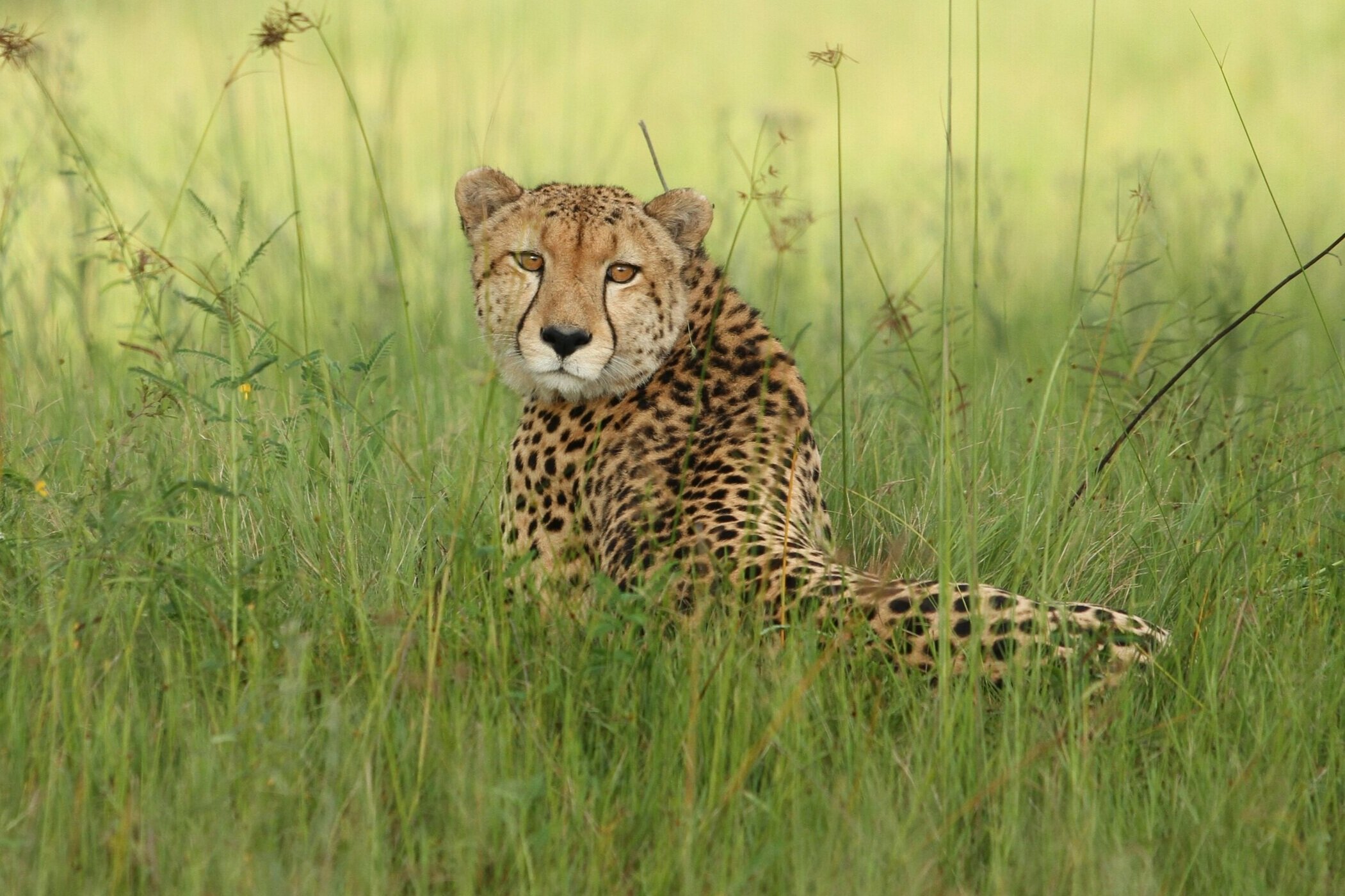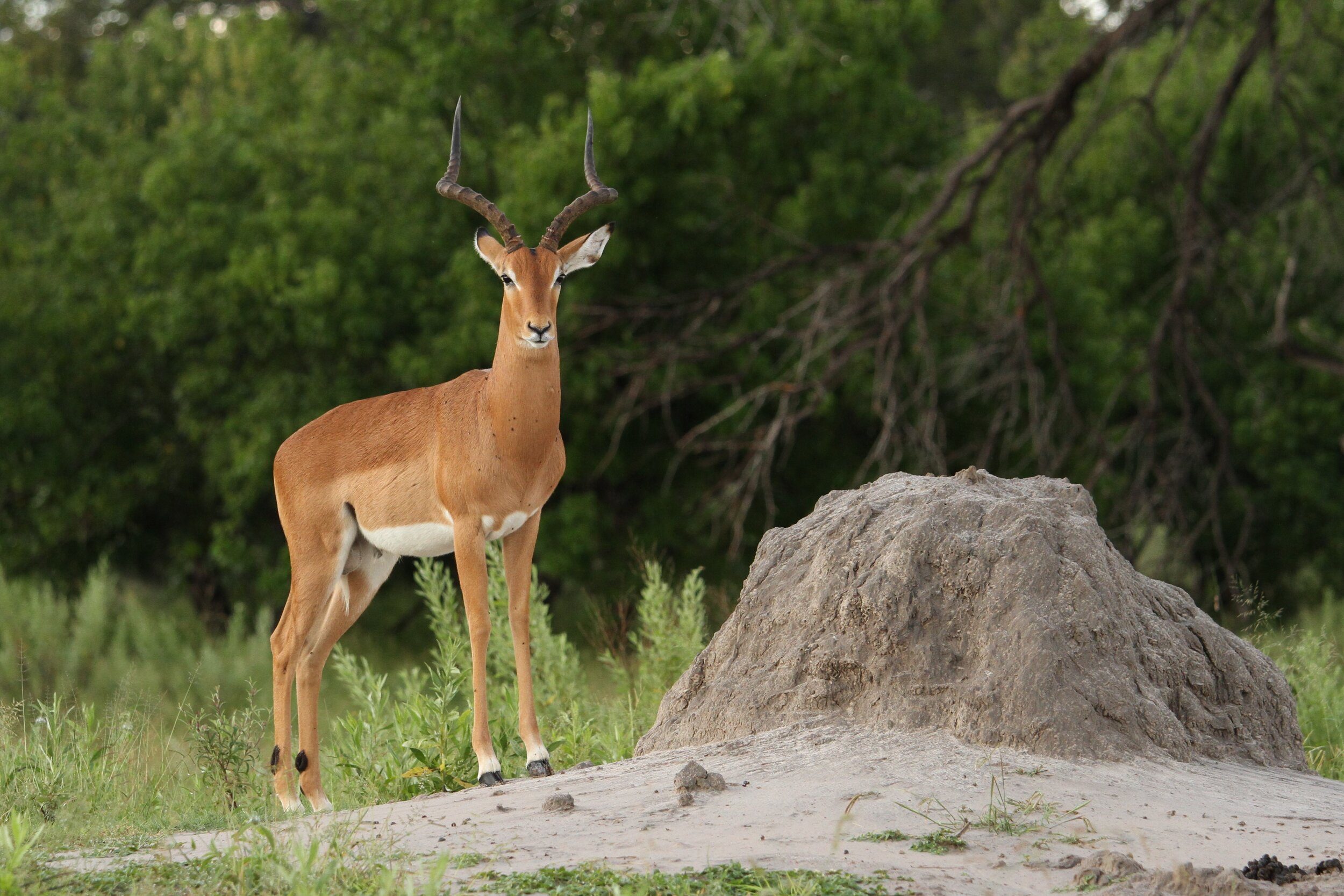
Africa’s Amazing Wildlife
“If we do not do something to prevent it, Africa’s animals, and the places in which they live, will be lost to our world, and her children, forever.”
— Nelson Mandela —
-
Lion (Panthera leo)
Size: Males 385-500 lbs. Females 260-315 lbs.
Lifespan: 15 years - Males less
Current Population: 20,000 to 30,000
Historic Population in 1950: 500,000
Threats: Habitat loss, loss of prey, conflict with humans and livestock, illegal wildlife trade, poaching, snares from illegal bush-meat trade, and trophy hunting.
A group of lions is called a “pride”
-
Leopard (Panthera pardus)
Size: Males 85-200 lbs. Females 60-130 lbs.
Lifespan: 12-17 years
Current Population: Difficult to estimate though more widespread with numbers greater than that of lions.
Historic Population: Difficult to estimate though much more widespread with numbers exponentially higher than today.
Threats: Habitat loss, loss of prey, conflict with humans and livestock, illegal wildlife trade, snares from illegal bush-meat trade, poaching, and trophy hunting.
A group of leopards is called a “leap”
-
Elephant (Loxodonta africana)
Size: Males 5-7 tons. Females 2.5-3.5 tons.
Lifespan: Up to 60 years
Current Population: 300,000 to 400,000 with approx. 1/3 of those in Botswana.
Historic Population early 1900’s: Greater than 10 million.
Threats: Habitat loss, conflict with humans (raiding crops, property destruction, loss of life) illegal wildlife trade for ivory, poaching, illegal bush-meat trade, and trophy hunting.
A group of elephants is called a “parade”
-
Cape Buffalo (Syncerus caffer)
Size: Up to 1700 pounds, with females slightly smaller.
Lifespan: 15-18 years
Current Population: 400,000
Historic Population: Widespread and in the millions.
Threats: Disease, illegal bush-meat trade, habitat loss, competition with livestock, poorly managed trophy hunting, and poaching.
A group of buffalo is called an “obstinacy”
Africa’s Diversity is Astonishing
1,100 species of mammals. 2,600 species of birds. 1,600 reptiles. 3,000 freshwater fish species. Over 3,000 different butterflies.
-

Cheetah (Acinonyx jubatus)
Size: Males 75-140 lbs. Females 50-120 lbs.
Lifespan: Males 9 years. Females 13 years.
Current Population: 7,000
Historic Population: Once widespread from Africa to the Middle East and to India.
Threats: Habitat loss, loss of prey, conflict with humans and livestock, illegal wildlife trade (especially the exotic pet trade), snares from the illegal bush-meat trade, poaching, disease, genetic isolation/inbreeding, and trophy hunting.
A group of cheetahs is called a “coalition”
-
White Rhino (Ceratotherium simun) and the Black Rhino (Diceros bicornis)
Size: White Rhino males up to 4,900 lbs. and females 3,500 lbs.
Black Rhino males up to 3,000 lbs. and females 2,800 lbs.
Lifespan: Up to 40 years
Current Population: Southern White Rhino - 17,000 to 19,000.
Northern White Rhino - Extinct in the wild.
Black Rhino - 5,000 to 6,000.
Historic Population 1900: 1,000,000
Threats: Habitat loss, poaching, illegal wildlife trade for horns, poaching, and trophy hunting.
IUCN Rating White Rhino: Near Threatened
IUCN Rating Black Rhino: Critically Endangered
A group of rhinos is called a “crash”
-
African Wild Dog (Lycaon pictus)
Size: 40-60 lbs. Males larger.
Lifespan: 10-12 years
Current Population: 6,600 (one of the most endangered animals in Africa).
Historic Population: Once widespread throughout Africa, wild dogs are found in isolated areas of Eastern and Southern Africa.
Threats: Habitat loss, loss of prey, conflict with humans/livestock, disease, snares from the illegal bush-meat trade, and poaching.
A group of wild dogs is called a “pack”
-

Giraffe (Giraffa camelopardalis)
Size: Males up to 4,250 lbs. and 18 feet tall. Females up to 2,600 lbs. and 16 feet tall.
Lifespan: Up to 25 years
Current Population: 117,000 among 4 distinct species of giraffe; Masai Giraffe, Reticulated Giraffe, Southern Giraffe, and Northern Giraffe.
Historic Population 1980’s: 155,000
Threats: Disease, illegal wildlife and bush-meat trades, conflict with humans (livestock and crops), habitat loss, poorly managed trophy hunting, and poaching.
A group of giraffes standing is called a “tower”
A group of giraffes moving is called a “journey”
Africa is home to 74 different species of antelope and 56 subspecies
The smallest, Royal Antelope, is only 6 pounds and 12 inches high. The largest, Giant Eland, weighs over a ton and stands 6 feet at the shoulder.
-
Spotted Hyena (Crocuta crocuta)
Size: Up to 180 pounds. Females approximately 10-12% larger than males.
Lifespan: Up to 20 years
Current Population: Widespread across Africa and across a variety of landscapes.
Historic Population: Widespread.
Threats: Conflict with humans/livestock and snares from the illegal bush-meat trade.
A group of hyena is called a “clan” and can number as high as 80 adults
-

Hippo (Hippopotamus amphibius)
Size: Males up to 5 tons. Females up to 3 tons.
Lifespan: Up to 50 years
Current Population: Though commonly seen in protected area, their numbers are a fraction of what they were a century ago.
Historic Population: Once widespread from the Nile delta to the cape of South Africa.
Threats: Habitat lost, human/wildlife conflict, hunting, poaching for ivory, illegal bush-meat trade, disease (anthrax).
A group of hippos is called a “raft”
-
Plains Zebra (Equus quagga)
Size: Males up to 700 pounds. Females up to 550 pounds.
Lifespan: Up to 20 years
Current Population: Commonly seen across many of Africa’s parks and preserves. 2 other zebra species, E. grevyi and E. zebra are both endangered, with E. grevyi the most critical at only 3,000 adults left in the wild.
Historic Population: Much more widespread than today.
Threats: Trophy hunting, habitat loss, disruption to migration routes, illegal bush-meat trade, and conflict with human/livestock.
A group of zebra is called a “dazzle”
-

Kudu (Tragelaphus strepsiceros)
Size: Males up to 700 pounds. Females up to 475 pounds.
Lifespan: Females up to 15 years. Males up to 10 years.
Current Population: Approximately 300,000.
Historic Population: More numerous, but estimates unknown. Found in a variety of habitats.
Threats: Trophy hunting, habitat loss, illegal bush-meat trade, snaring, and poaching for horns and hides.
A group of kudu is called a “herd”
Africa’s wildlife need our help!
50 years ago there were 200,000 lions. Today there are less than 30,000. 100 years ago there were 10 million elephants. Today there are 400,000. The story is the same for most animals across the world Habitat loss, poaching, the illegal wildlife trade, hunting, poverty, increasing human population, climate change, drought, famine, conflict with livestock, mining, oil and gas exploration, and more threaten the future of wildlife and people.
-

Wildebeest or Gnu (Connochaetes taurinus)
Size: Up to 600 pounds. Females smaller.
Lifespan: Up to 20 years
Current Population: Over 1 million
White Bearded Wildebeest - Kenya and Tanzania that make up the massive Serengeti Migration and the smaller Loita Hills Migration.
Blue Wildebeest - More confined to the protected areas of Southern Africa.
Historic Population: More numerous. Unknown estimates.
Threats: Loss of habitat, disruptions to migration corridors, illegal bush-meat trade, poorly regulated trophy hunting, competition with livestock for resources, and poaching.
A group of wildebeest is called an “implausibility”
-

Eland (Taurotragus oryx)
Size: The largest of the antelope. Males up to 1 ton. Females up 1300 pounds.
Lifespan: Up to 20 years
Current Population: 100,000. Occupy only 50% of their historic range. Of the current population, approximately half are only found in protected areas.
Historic Population: Once found from the tip of South Africa up to the floodplains of the Nile River.
Threats: Loss of habitat, competition with livestock, hunting, poaching, and the illegal bush-meat trade.
A group of eland is called a “herd”
-
Impala (Aepyceros melampus)
Size: Males up to 110 pounds. Females up to 90 pounds.
Lifespan: Up to 12 years
Current Population: 2,000,000. 25% of current population is only found in protected areas.
Historic Population: More numerous. Estimates unknown.
Threats: Hunting (especially South Africa), habitat loss and fragmentation, competition with livestock, poaching, and the illegal bush-meat trade.
A group of impala is called a “rank”
-

Red Lechwe (Kobus leche leche)
Size: Males up to 285 pounds. Females up to 200 pounds.
Lifespan: Up to 15 years
Current Population: 80,000 limited to isolated areas within marshes and wetlands. Commonly seen in the Okavango Delta. Related species, black and kafue lechwe, are found in Zambia in smaller numbers and similar habitats.
Historic Population: Unknown, but greater than current estimates.
Threats: Illegal-bush meat trade, poaching, habitat loss, drought, building of dams, hunting, and competition with livestock for food and water.
A group of lechwe is called a “herd”
“If all the beasts were gone, men would die from a great loneliness of spirit, for whatever happens to the beasts also happens to man. All things are connected. Whatever befalls the Earth befalls the sons of the Earth.”
— Chief Si'ahl (Seattle) —








